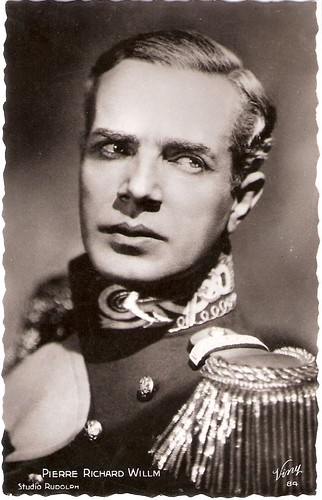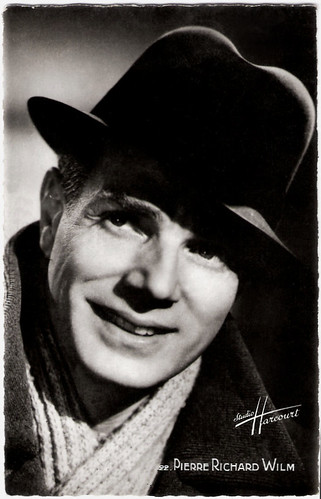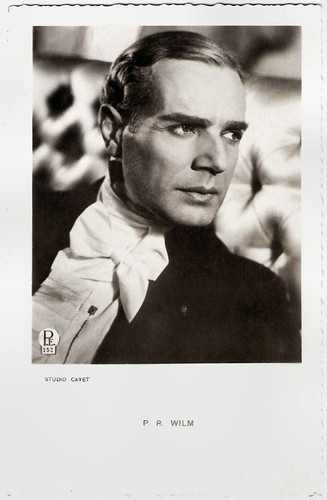Elegant French actor Pierre Richard-Willm (1895-1983) starred in 40 films during the 1930s and the first half of the 1940s. The good-looking jeune premier excelled in the foreign legion melodrama Le Grand Jeu/The Great Game (1934) and as Edmond Dantès in Le Comte de Monte-Cristo/The Count of Monte-Christo (1943).

French postcard, no. 31. Photo: publicity still for Stradivarius (Albert Valentin, Géza von Bolváry, 1935).

French postcard by A.N., Paris, no. 609. Photo: Studio Lorelle.

French postcard by Editions Chantal, no. 31. Photo: R. Voinquel / Flora Films / Productions Max Glas.

French postcard by EC, no. 43.

French postcard, no. 43.
Pierre Richard-Willm was born as Alexander Pierre Richard in south-western France in the city of Bayonne in 1895. His mother, Elisabeth-Fanny Willm, died at the age of thirty-one, and from 1905 on he was raised by his maternal grandmother in Bordeaux.
He attended the école des Beaux-Arts in Nantes. Theatre was his passion and in 1911 he started as an amateur at the Théâtre du Peuple de Bussang.
In 1916 he joined the army and fought during World War I at Verdun. After the war he became a sculptor, and in 1921 he started playing bit roles on the professional stage.
From 1925 on he worked at the Odeon in Paris in plays like La dame aux camélias under the pseudonym Richard Willm, the combined name of his father and mother.
His film debut as a jeune premier came in the Paramount production Toute sa vie/Sarah and Son (Alberto Cavalcanti, 1930), followed by another film by Alberto Cavalcanti for Paramount, Les Vacances du diable/The Devil's Holiday (1931).
With his elegance and good looks he charmed spectators of all ages. The next years he made dozens of films, including French versions of Ufa productions including Autour d'une enquête/Preliminary Investigation (Pierre Chomette, Robert Siodmak, 1931) starring Annabella, and La fille du régiment/The Daughter of the Regiment (Pierre Billon, Carl Lamac, 1933) starring Anny Ondra.

French postcard by EC, no. 985. Photo: Studio Rudolph, Paris.

French postcard by Editions et Publications cinematographiques, no. 29. Photo: Forster.

French postcard by Viny, no. 81. Photo: Studio Rudolph.

French postcard by Viny, no. 84. Photo: Studio Rudolph.

French postcard, no. 134. Photo Studio Harcourt.

French postcard by S.E.R.P., Paris, no. 134. Photo: Studio Harcourt.
Pierre Richard-Willm’s breakthrough was the foreign legion melodrama Le Grand Jeu/The Great Game (Jacques Feyder, 1934), in which he starred opposite Charles Vanel and Marie Bell.
In the following years he often played the partner of diva Edwige Feuillère in such films as Stradivarius (Albert Valentin, Géza von Bolváry, 1935), Barcarolle (Gerhard Lamprecht, Roger Le Bon, 1935), La Dame de Malacca/Woman of Malacca (Marc Allégret, 1937) and La Duchesse de Langeais/Wicked Dutchess (Jacques de Baroncelli, 1942).
Famous director Max Ophüls directed him in Yoshiwara (1937) and Werther (1938).
A big hit was Un Carnet de bal/Dance Program (Julien Duvivier, 193) in which Marie Bell stars as a woman who decides to find out about the men (including Pierre Richard-Willm) who once danced with her during a ball that was a turning point in her life.
His most famous role was Edmond Dantès in two episodes of Le Comte de Monte-Cristo/The Count of Monte-Christo (Robert Vernay, 1943) based on the famous novel by Alexandre Dumas père.
He starred as composer Franz Liszt in Rêves d'Amour/Dreams of Love (Christian Stengel, 1942-1947), for which film he also designed the sets.
In 1946 he decided to retire from the cinema and to dedicate himself completely to his beloved Theatre Vosgien.
In 1975 he wrote his memoires, Loin des Étoiles (Far from the stars), in which he wrote that the cinema had only been a nice intermission for him.
Pierre Richard-Willm died in 1983 in Paris.

French postcard by Ed. Chantal, Rueil, no. 43B. Photo: Roger Richebé.

French postcard, no. 633. Photo: Chromos Film.

French postcard by Editions P.I., Paris, no. 20. Photo: Teddy Piaz.

French postcard by O.P., Paris, no. 2. Photo: Studio Piaz.

French postcard by S.E.R.P., Paris, no. 22. Photo: Studio Harcourt.

French postcard by EPC, no. 246. Photo: Studio Harcourt.

Belgian postcard by P.E. (Photo Édition), no. 152. Photo: Studio Cayet.
Sources: Caroline Hanotte (Cineartistes.com), Franck Richard, Wikipedia and IMDb.

French postcard, no. 31. Photo: publicity still for Stradivarius (Albert Valentin, Géza von Bolváry, 1935).

French postcard by A.N., Paris, no. 609. Photo: Studio Lorelle.

French postcard by Editions Chantal, no. 31. Photo: R. Voinquel / Flora Films / Productions Max Glas.

French postcard by EC, no. 43.

French postcard, no. 43.
Charming Spectators Of All Ages
Pierre Richard-Willm was born as Alexander Pierre Richard in south-western France in the city of Bayonne in 1895. His mother, Elisabeth-Fanny Willm, died at the age of thirty-one, and from 1905 on he was raised by his maternal grandmother in Bordeaux.
He attended the école des Beaux-Arts in Nantes. Theatre was his passion and in 1911 he started as an amateur at the Théâtre du Peuple de Bussang.
In 1916 he joined the army and fought during World War I at Verdun. After the war he became a sculptor, and in 1921 he started playing bit roles on the professional stage.
From 1925 on he worked at the Odeon in Paris in plays like La dame aux camélias under the pseudonym Richard Willm, the combined name of his father and mother.
His film debut as a jeune premier came in the Paramount production Toute sa vie/Sarah and Son (Alberto Cavalcanti, 1930), followed by another film by Alberto Cavalcanti for Paramount, Les Vacances du diable/The Devil's Holiday (1931).
With his elegance and good looks he charmed spectators of all ages. The next years he made dozens of films, including French versions of Ufa productions including Autour d'une enquête/Preliminary Investigation (Pierre Chomette, Robert Siodmak, 1931) starring Annabella, and La fille du régiment/The Daughter of the Regiment (Pierre Billon, Carl Lamac, 1933) starring Anny Ondra.

French postcard by EC, no. 985. Photo: Studio Rudolph, Paris.

French postcard by Editions et Publications cinematographiques, no. 29. Photo: Forster.

French postcard by Viny, no. 81. Photo: Studio Rudolph.

French postcard by Viny, no. 84. Photo: Studio Rudolph.

French postcard, no. 134. Photo Studio Harcourt.

French postcard by S.E.R.P., Paris, no. 134. Photo: Studio Harcourt.
Count of Monte Christo
Pierre Richard-Willm’s breakthrough was the foreign legion melodrama Le Grand Jeu/The Great Game (Jacques Feyder, 1934), in which he starred opposite Charles Vanel and Marie Bell.
In the following years he often played the partner of diva Edwige Feuillère in such films as Stradivarius (Albert Valentin, Géza von Bolváry, 1935), Barcarolle (Gerhard Lamprecht, Roger Le Bon, 1935), La Dame de Malacca/Woman of Malacca (Marc Allégret, 1937) and La Duchesse de Langeais/Wicked Dutchess (Jacques de Baroncelli, 1942).
Famous director Max Ophüls directed him in Yoshiwara (1937) and Werther (1938).
A big hit was Un Carnet de bal/Dance Program (Julien Duvivier, 193) in which Marie Bell stars as a woman who decides to find out about the men (including Pierre Richard-Willm) who once danced with her during a ball that was a turning point in her life.
His most famous role was Edmond Dantès in two episodes of Le Comte de Monte-Cristo/The Count of Monte-Christo (Robert Vernay, 1943) based on the famous novel by Alexandre Dumas père.
He starred as composer Franz Liszt in Rêves d'Amour/Dreams of Love (Christian Stengel, 1942-1947), for which film he also designed the sets.
In 1946 he decided to retire from the cinema and to dedicate himself completely to his beloved Theatre Vosgien.
In 1975 he wrote his memoires, Loin des Étoiles (Far from the stars), in which he wrote that the cinema had only been a nice intermission for him.
Pierre Richard-Willm died in 1983 in Paris.

French postcard by Ed. Chantal, Rueil, no. 43B. Photo: Roger Richebé.

French postcard, no. 633. Photo: Chromos Film.

French postcard by Editions P.I., Paris, no. 20. Photo: Teddy Piaz.

French postcard by O.P., Paris, no. 2. Photo: Studio Piaz.

French postcard by S.E.R.P., Paris, no. 22. Photo: Studio Harcourt.

French postcard by EPC, no. 246. Photo: Studio Harcourt.

Belgian postcard by P.E. (Photo Édition), no. 152. Photo: Studio Cayet.
Sources: Caroline Hanotte (Cineartistes.com), Franck Richard, Wikipedia and IMDb.
...traigo
ReplyDeletesangre
de
la
tarde
herida
en
la
mano
y
una
vela
de
mi
corazón
para
invitarte
y
darte
este
alma
que
viene
para
compartir
contigo
tu
bello
blog
con
un
ramillete
de
oro
y
claveles
dentro...
desde mis
HORAS ROTAS
Y AULA DE PAZ
TE SIGO TU BLOG
CON saludos de la luna al
reflejarse en el mar de la
poesía...
AFECTUOSAMENTE
ESPERO SEAN DE VUESTRO AGRADO EL POST POETIZADO DEL FANTASMA DE LA OPERA, BLADE RUUNER Y CHOCOLATE.
José
Ramón...
Handsome! Always interesting to read about a career that spanned decades. He saw cinema develop during his lifetime.
ReplyDeleteIt must be unusual for an actor to leave the bright lights of cinema for the relative obscurity of provincial theatre. Probably a great deal more fulfilling though.
ReplyDeleteI do remember that scene in Battleship Potemkin!
Interesting to learn about another European Film Star. I bet his memoires are interesting to read.
ReplyDeleteJudy
I suppose that's the sign of a great actor, one who could remain active throughout many years.
ReplyDeleteWhat mesmerising eyes.
ReplyDeleteMany actors first love seems to be the theatre.
I like the last postcard the best. thanks for visiting my blog, and Happy PFF!
ReplyDeleteWhat is it about actors and their eyes? Just the way they are photographed or is it in the genes?!! Always interesting posts.
ReplyDeleteA striking looking gentleman for sure. Interesting information!
ReplyDelete